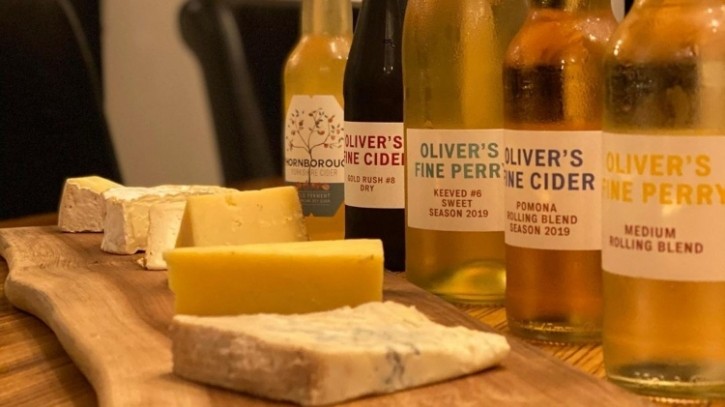OPINION
Matching cheeses with ciders

Two of the most prestigious cheese-making regions, Normandy and Somerset, are also renowned cider producing areas and the match of a dry West Country cider to Cheddar, or a naturally sweet Normandy cidre to Camembert, is hard to beat.
In fact Joseph Harding, a dairy consultant responsible for hugely improving Cheddar making techniques, struggled to convince Cheddar makers in Somerset that were using their warm lofts to mature their cheeses to start maturing cheeses in their cellar instead, because, they said, “that’s where the cider goes, we haven’t got room down there for cheese.”
But the import of wine soon led to a move away from consuming cider, and like cheese, its history is a chequered one; cider slipped from being a true quality drink to being mass-produced, made with a minimum of apple juice itself (just 35% juice allows the end product to be called cider, the other 65% can be made up from anything that will ferment – often sugar and water). This mass-produced product was a completely different drink from its naturally fermented, 100% apple juice namesake.
But in recent years, proper artisan production of cider and perry has started to flourish again.
A whole range of types of apple and pear to ferment, and a choice of various methods of fermentation and ageing, leads to an incredibly diverse range of artisan ciders and perries now available. “This gives us a plenty of ciders and perries to choose from to pair against any style of cheese, so you can get a perfect match,” says Kingsley Ash of Yorkshire’s Thornborough Cider.
Which leads us on to a selection of ideal cheese and cider pairings:
“Sometimes the ideal partner is complementary and echoes certain traits – gentle acidity in the drink paired with a citric tang in the cheese, for example,” says cider aficionado Cellarman Sam. “This is a pairing of subtlety and nuance. And sometimes the partner is contrasting: it sits at the other end of the flavour spectrum. Salt and sweet is the classic. Balance is key here – it’s a pairing of high drama and jeopardy, tip too far in one direction and it all becomes too much.”
Matching cider to goats’ and sheep’s cheeses
The fresh, acidic flavours of many younger goats’ cheeses match really well with a naturally fizzy bottle-fermented perry or cider (look for ‘Champagne Method’ on the label). Ciders and perries made only with desert apples (often associated with the east coast of England, from Kent upwards) keep a bright acidity and lack tannins and bitterness – as a result they complement the freshness of goats’ and sheep’s cheeses very well.
Famous cider-maker Tom Oliver from Hertfordshire marks this as his favourite match: “I really enjoy the interplay between perry and a soft goats’ cheese. For example, Dorstone, a soft goats’ cheese, paired with an Oliver’s Sweet Juice Perry. I think it may be the soft texture foiled by the citrus zing from the perry and lemony hints from the cheese.”
The sweeter notes found in sheep’s cheese (such as Manchego) match well to a slightly sparkling perry or medium cider (not too tannic) as the fruitiness and sweetness complement the richness of the sheep’s milk.
Matching cider to hard cheeses
Hard cheese varies in style so much it’s easier to split it into three broad categories:
Crumbly-cheeses, such as Lancashire, Wensleydale and Cheshire:
- Like the goats’ cheese, the fresh, light vibrant acidity to these cheeses is best matched to something that won’t overpower it – slightly sparkling perries and crisp dry ciders made with desert apples fit this bill.
- Cider maker Kingsley Ash has chosen as his perfect match a crisp, eastern-style, dessert-apple cider (Thornborough Cider) with Old Roan Wensleydale or Kirkham’s Lancashire.
Harder British territorial-cheeses, such as Cheddar and Leicester:
- The tannic structure and pleasant astringency of West Country cider apples stand up to the savoury/salty and rich notes you get with strong Cheddar. It is hard to beat this classic combination. For example Cheddar accompanied by a West-Country Cider like Tom Oliver’s Pomona Rolling, or single varietals like the naturally sweeter caramel-cider-apple Yarlington Mill. “I really enjoy a rich, tannic, sparkling cider with Cheddar – the range of cheddars it can work with is amazing, from Keens and Montgomery to Westcombe and Hafod,” says Tom Oliver.
Continental-style hard cheeses, such as Parmesan and Comté:
- For an older variety of cheese, try a classic dry cider, something that’s not too bold that could overpower the sweetness in these hard cheeses. Old Winchester paired with Tom Oliver’s Pomona Rolling, for example. Cider makers have been experimenting recently with adding hops to their cider (in the same way as they are added to beer) and the resulting bitterness and citric notes are also worth an experimental match in this area.
- If the cheese is very sharp and long-aged (for example Old Winchester) then it can stand being paired with something even bolder such as the barrel-aged Gold Rush.
Matching cider to soft cheeses
White-rinded soft cheese such as Brie, Camembert and Tunworth:
- The buttery-creaminess of these cheeses demands a cider that is rounded, with some fruitiness through to an off-dry/medium flavour, or a gently sparkling perry or cider. Quality flavoured ciders are also worth an experiment here (consider how well Brie goes with cranberries), especially those with notes of cherry or strawberry.
Washed (red) rinded soft cheeses such as Epoisses, Stinking Bishop and St James:
- These often have savoury notes and pungent flavours, so a cider that complements the wild, intense yeasty notes goes well here – deep, tannic barrel-fermented ciders like Gold Rush, a classic cloudy Scrumpy, are good places to start.
Matching cider to blue cheeses
The strength and richness of blue cheese means they need a cider with body and power to stand up to them.
This body and power comes in two forms:
- A big, powerful barrel-fermented cider which brings out the smokiness and richness in the apples, such as Oliver’s Gold Rush, or
- A sweet cider or perry, where the sweetness gives richness and body that stands up to the strong flavours in blue cheese.
- Look for a cider that is naturally sweet rather than sweetened with sugar or apple juice.
- The best types of sweet cider tend to be an ice cider, picked when the apples are frozen, or a ‘Keeved’ cider, where the fermentation is naturally halted*
- This is one of cider expert and owner of The Fine Cider Company Felix Nash’s favourite matches of all time: “Rich salty blue cheese meets sumptuous sweet ice cider, with a cleansing bit of acid. And of course, this fits well as an after dinner ritual. The salt and sweetness play off each other. I’d go for a creamy rich blue, like Pevensey Blue, or Stichelton, with a Brannland Ice Cider. For a Keeved cider great British examples include Oliver’s The Next Big Thing or Pilton’s Keeved Cider”
With such a range of cider and cheese flavours out there, take Felix Nash’s advice and play around with different matches: “Look for the way the taste changes between the two things you’re pairing – how the taste of the cheese is altered by the cider, and how the cider is changed by the cheese. When it’s really good, the transition will be a longer, more interesting one, which elevates both in the process!”
As the original ‘English-wine’ perry and cider have probably been drunk with cheese in the UK for longer than wine has! It’s time for cider and perry to regain that crown as a perfect match for cheese.
The Courtyard Dairy is a cheese shop and cheese maturer at Crows Nest Barn, Austwick, near Settle, North Yorkshire.







